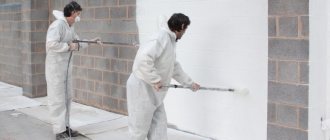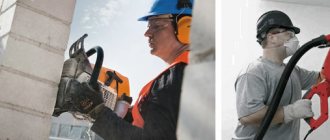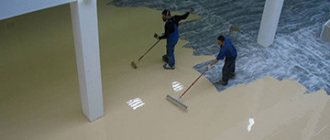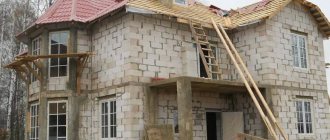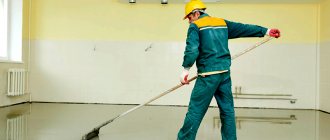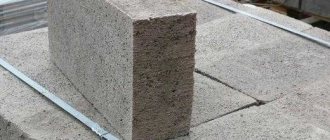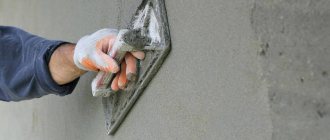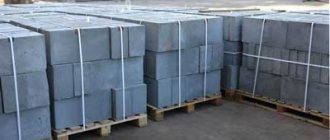Porosity of the material is the main problem that needs to be solved. The first thing that comes to mind is plastering the walls: with its help you can achieve the evenness of the future surface. For leveling, different types of solution are used:
- Cement-sand plasters and their derivatives (lime, sand-lime);
- Gypsum compositions for treating the internal surface.
Before plastering the wall, it is carefully primed with a special deep penetration compound to reduce material consumption. It is recommended to make 2-3 passes with soil.
After applying the base layer of preparation, the finished wall is again treated with primer before finishing painting.
Types of paint for aerated concrete
From a chemical point of view, paint is a mixture of pigments, fillers and binders. Pigments are used to give paintwork materials the required color and special properties: anti-corrosion, resistance to ultraviolet radiation and aggressive environments.
Base compounds in accordance with GOST R 56585-2015 are used as pigments. But different fillers and binders are used in paints. The physical and operational characteristics of paint coatings depend on their properties. Types of paints depending on composition:
Water soluble
This is a façade paint for aerated concrete, which contains a polymer filler and the solvent is water. Additionally, plasticizers, modifiers, and driers (hardeners) are added to the composition. The material creates a sealed layer on the surface to be painted that does not allow moisture to pass through, which means it is suitable for painting aerated concrete walls without plaster. This is an excellent choice when you need to paint aerated concrete cheaply: the paint is applied with ordinary painting tools, and no preliminary primer is required.
- environmental friendliness - does not contain hazardous compounds;
- Easy to apply - no protective suit required;
- quick drying at temperatures +20°C and above;
- thin layer - one layer is enough for painting;
- Service life before coating renewal is up to 3 years.
- cannot be used at temperatures below +15°C and high air humidity;
- requires regular updating.
Silicate
They are produced on the basis of silicate - liquid glass. They protect surfaces well from ultraviolet radiation, temperature changes, and moisture. Silicate coatings are not intended for application to concrete, stone, and ceramic surfaces due to low adhesion. Therefore, painting aerated concrete with silicate paint without prior plastering is impossible. Before applying silicate paint, the plaster must be treated with a silicone primer. Only in this case will silicone paint for aerated concrete stick to the surface and perform its intended functions.
- protection of the facade from climatic factors;
- bright, rich, deep color;
- self-cleaning in the rain;
- service life before coating renewal is from 5 years.
- applied only to plaster;
- require the use of silicone primer;
- contain alkali - a protective suit is required when applying;
- poorly cleaned from the surface.
Oily
An outdated type of coatings based on drying oil. Turpentine, benzene or white alcohol are used as a diluent. Oil-based paints are quite toxic, so they are currently used primarily for outdoor use. The material is applied to cellular concrete only after preliminary priming. Painting aerated concrete without plaster on the outside of the house with oil paint is possible, but not advisable due to the large number of disadvantages.
- low price;
- applied by hand.
- painted aerated concrete takes a long time to dry;
- when dried, toxins and a characteristic odor are released;
- form streaks on the wall;
- light colors turn yellow over time;
- service life before updating is several seasons.
Acrylic
Acrylic resin is used as a binder in acrylic coatings. On the surface to be painted, the material forms a dense film that does not allow moisture to pass through, but ensures unhindered air circulation. If you are deciding how to paint the outside of aerated concrete blocks, then vapor-permeable paint for aerated concrete based on acrylates is a good option. Acrylic paints have excellent adhesion to aerated concrete and can be applied without plaster or primer to a cleaned surface. The structure of the coating material is highly elastic, which makes it well adapted to the specifics of the aerated block.
- tinted in any color from the RAL catalogue;
- high resistance to ultraviolet radiation;
- highest mechanical resistance;
- cover cracks in aerated concrete up to 1.5 mm deep;
- frost resistance and resistance to temperature changes;
- protect the surface from corrosion, which is important for reinforced aerated concrete blocks;
- service life before coating renewal is up to 5 years.
- can only be applied to dry surfaces;
- relatively high price.
Polymer
The binder in these coloring compositions is an emulsified polymer-based resin. Polymer coatings form a water-repellent film on the surface of cellular concrete, which at the same time perfectly allows air to pass through. Polymer facade paint for aerated blocks can be applied both to fresh plaster and directly to the aerated block. In this case, the surface does not have to be completely dry, as acrylic paints require. Polymer paint compositions can also be applied over the old layer of paint, which is especially important if the house has been repainted many times. Polymer paint can be applied at temperatures down to -10°C, so this option is suitable for those who are thinking about how to paint aerated concrete blocks outside for the winter.
- create a durable glossy finish;
- give the surface a prestigious look;
- resistant to all climatic factors;
- resistant to aggressive environments;
- self-clean in the rain, repel dirt;
- applied at temperatures from +35 to -10°C;
- fill cracks up to 5 mm deep in the structure of the aerated block;
- service life before coating renewal is up to 7 years.
- high price;
- decent consumption per 1 m² of aerated block wall.
Vinyl
Vinyl coatings are produced on the basis of polyvinyl acetate. Vinyl creates a film with low vapor permeability on the surface, so this paint is not used for aerated concrete without plaster. The material is applied only to a previously plastered surface. In this case, the plaster layer must gain full strength. Recently, the volume of use of vinyl paint compositions in the field of exterior decoration has decreased significantly. They are trying to replace outdated vinyl with more durable acrylic or polymer materials.
- low price and low consumption;
- dense coverage even in one layer;
- UV resistance;
- environmental friendliness.
- washed off with water;
- service life - 1-2 seasons;
- lack of vapor permeability.
Water-epoxy
Paint and varnish compositions based on epoxy resins have excellent adhesion to cellular concrete, so they can be used to paint aerated concrete walls without plaster. A durable, waterproof layer is created on the surface.
The peculiarity of epoxy-water-based paints is their brightness of color and high durability. The painted surface can withstand heavy loads, and the color does not fade or fade. The paint can be applied to wet concrete, which means it is an excellent choice for those who have finished building a house in the fall and are deciding how to paint the outside of aerated concrete blocks for the winter.
- high resistance to all operational factors;
- excellent adhesion to aerated concrete blocks;
- the presence of different textures;
- can be applied to a damp aerated block;
- service life before updating is up to 10 years.
- toxic before hardening - protective suit required;
- high price.
Tool
To carry out the work you will need tools and building materials:
- construction spatulas of different sizes and purposes;
- for painting rollers and brushes;
- painting cuvette;
- sandpaper with fine and coarse grains;
- construction hammer;
- pliers;
- putty composition;
- paint and varnish products.
Depending on the condition of the external walls of the facility, you may need:
- degreasing solution;
- to eliminate cracks and seal seams - gypsum;
- masking tape;
- stain removers for plaster.
Why is vapor permeability so important?
When choosing, the consumer should focus on the basis of the material. Let’s immediately make a small digression and clarify that for a façade made of aerated concrete blocks, the most suitable paints are those that allow steam to pass through well. To be more precise, for the external coating it is important to let in the same amount of steam per square meter as the wall itself. For laying the external walls of buildings today, D500 blocks are most often used, the vapor permeability of which is on average 0.2 mg/m*h*Pa - remember this value.
The whole point of finishing a wall made of aerated concrete blocks is to protect the material from water penetrating into it, and not to prevent it from escaping outside. Water can enter the structure of blocks through direct contact (precipitation, flooding) or in the form of steam, which is formed in large quantities in residential heated premises. The main part of the steam goes in the direction from bottom to top and is removed from the rooms through the ceilings and roofing. The walls remove much less moisture through themselves, but if it does not go outside, over time the aerated concrete will get wet through and through, which will greatly affect its strength and thermal insulation characteristics.
A proper aerated concrete wall must be covered from the inside with vapor-tight materials. The materials used for interior decoration reduce the overall vapor permeability of the wall, so in the calculations it is correct to use not the indicator 0.2 mg/m*h*Pa, but the one that has a separate material.
The following factors must be understood and taken into account:
- Over time, the decoration in the rooms may change, which means its vapor permeability coefficient will also change;
- In all rooms, different materials are used for decoration, and the paint on the facade is the same, so you should focus on the finishing material with the greatest vapor permeability;
- Even if the finish effectively retains steam, it can still pass into the thickness of the walls through small defects in it, technical unsealed components and other weak points. Therefore, it is always worth making a reserve when calculating the vapor permeability of facade paint. The plaster, by the way, must also be vapor-permeable.
To briefly summarize all that has been said, the choice of paint for the facade of an aerated concrete block must be considered in conjunction with the structure of the wall and interior decoration. That is, we are talking about a single system - a wall pie.
Now let's look at the most common paint options on sale.
Acrylic paints and latex
Pure acrylic paints are usually not used for facades. Most often, the base is acrylate (acrylic mixed with latex), or latex in its pure form. Thanks to the combination of two polymers, it is possible to increase the level of vapor permeability of the coating.
They are deep-matte aqueous dispersions sold in plastic buckets of various sizes. After application and drying, they form a film on the surface that is resistant to precipitation and ultraviolet radiation. In addition, the material has good dirt- and water-repellent properties. The service life of the coating largely depends on the quality of the raw materials used in production, and they can be very different, which explains such a large difference in prices.
Despite the fact that water-dispersion compositions are made on a water basis, after polymerization they become insensitive to it, since a completely different molecular structure is formed. They are like cement, which is initially easily dissolved by water, and after hardening it stops mixing with it.
Acrylic paint is used for interior and exterior work. If we consider it in relation to an aerated concrete wall, then the composition is ideal for interior decoration, since the average vapor permeability is 0.7-1 mg/m*h*Pa. This indicator depends on the composition of the material, so when choosing, carefully read the manufacturer’s instructions - all the necessary data is indicated on the label.
For exterior use, this paint is suitable only if there is a barrier to steam passage inside the wall or inside the room. For example, the wall is additionally insulated with extruded polystyrene foam. Acrylic paints are inelastic without the addition of latex, so they do not hide small irregularities well and are not resistant to cracks in the base. However, they have good mechanical strength and do not get dirty like lime compounds.
Types of materials and methods of interior finishing
If you are thinking about how to decorate aerated concrete walls, you can consider several options at once. Among others, drywall can be distinguished. When leveling the walls, you should choose 12 mm sheets, and for the ceiling you should use a thickness of 9 mm sheets. This leveling allows you to prepare the surface before painting or wallpapering.
You can level the gas block by installing the frame and sheathing it or gluing gypsum board sheets directly to the wall. The inside of an aerated concrete house is often lined with clapboard; it consists of natural wood and only maintains a favorable microclimate.
Under such finishing it will be necessary to install a frame, between the slats of which a distance of 40 cm is maintained.
The inside of the block can also be sheathed with plastic panels; they will also need sheathing, the intermediate rows of which are installed in increments of 50 cm. Decorative elements can be secured with nails or a stapler. If you still can’t decide how to decorate the room, you can pay attention to ceramic tiles. It is suitable for rooms with special conditions, such as kitchens or bathrooms. The material does not allow moisture to pass through and will protect the concrete from getting wet. You need to use special-purpose glue for masonry. It is recommended to use a special plaster for interior finishing of walls made of aerated concrete blocks, which is offered at different prices, taking into account its capabilities.
Wood
Interior finishing of aerated concrete can be done with wood. Other solutions include:
Natural material is perfect for aerated concrete. It allows air to pass through and helps regulate humidity. In order to install one of these finishes, you will need to install guide bars. Their thickness should be 2 cm. Fastening is carried out using dowels, but if the loads are expected to be significant, such fasteners may not withstand.
To solve the problem, it is necessary to fix it to the reinforcement strapping that is present in the masonry.
The sheathing is installed in the direction specified by the location of the cladding. The distance between the slats should be the width of the boards. It is necessary to retreat about 15 cm from the ceiling and floor in order to install the rows of the frame. The sheathing is attached to the sheathing frame. This finish does not provide for waterproofing. If necessary, the wood can be painted to highlight its natural texture or give it a certain shade.
Ceramic tile
Ceramic tiles look great in the apartment. Usually it is used for damp rooms. The walls will need to be primed, but first check them for evenness. If there are significant defects, the glue consumption will be greater. When the deviations are more than a centimeter, you need to first plaster the walls. The glue is applied to the wall, and then the tiles are applied to the surface. It can be adjusted over a certain period of time, so you should not prepare the composition in too large quantities, nor should you apply it to the wall over a large area. The level will allow you to level the position of the first row. After 15 minutes, it will no longer be possible to move the products.
Wallpapering walls
There is probably not a single apartment where you cannot find wallpaper. This cladding is good because you can decorate walls with it yourself. The wall is pre-leveled; for this you can use drywall or plaster. It is necessary to use a primer, which will not only increase adhesion, but also reduce the ability of materials to absorb moisture, which means that the glue will perform its task well.
It is better to start finishing work six months after the completion of the house, as it will shrink, which can lead to rupture of the cladding. You can additionally reinforce the walls with fiberglass mesh and also cover them with plaster, which will make the finish more durable. If it was not possible to choose wallpaper with vapor-permeable properties, you can install supply and exhaust ventilation.
PVC panels
The interior decoration of a house made of aerated concrete can be done with PVC panels. After preparing the walls or eliminating defects using putty, you should make sure that the plastic has been acclimatized. To do this, it is kept in the room for about 10 hours, and then the back surface is degreased. The glue is applied in dots or dotted lines on the reverse side of the products. They are pressed against the wall, and after installing the framing profile, dirt is removed. This finishing of aerated concrete walls from the inside by installing panels with liquid nails or glue is the simplest and fastest.
Clapboard finishing
This cladding is installed on walls without obvious defects that could interfere with the installation process. Protruding areas are knocked down, and large potholes are filled with plaster if necessary. The lining must be treated with antiseptic materials to prevent rotting and the occurrence of fungus. The material is left in a well-ventilated area where it should dry.
The slats are installed on the sheathing; this can be done using the method of hidden or external fastening. In the first case, fastening is carried out in the grooves, and the overlap will be carried out by the lock of the next product. Special fasteners can be clamps, which look like grips.
Plastic panels
Decorating a house made of aerated concrete is less often done with plastic panels, because their vapor permeability is not so high, and such products look quite cheap. But if the budget is limited, such cladding will be the best solution. A frame is assembled on the wall in the form of profiles - square slats with a side of 50 mm. They must be dry and treated with an antiseptic.
The position of the elements must be perpendicular to the plastic panels. When cladding partitions or walls, special dowels for cellular materials should be used. The panels will be connected to each other using a tongue and groove lock. If they are positioned horizontally, the tenon should face upward. PVC panels are suitable for wet rooms, but if we are talking about a bathhouse, then it is better to avoid using them, since the material cannot withstand high temperatures.
Plaster as a finishing option
Aerated concrete blocks in an apartment are best finished with plaster. The walls can be treated with a float or plane for leveling, but it is better to do this at the construction stage. In order to remove dust from the surface, water is applied to it using a brush or roller, and then the walls can be primed. Before plastering, beacons should be installed, after which you should begin casting the first layer from bottom to top along the beacons. The surface is leveled, and after the first layer has dried, it is moistened and leveled.
Painting aerated concrete surfaces
How to finish aerated concrete walls indoors. If you are also interested in this issue, you can consider the option of staining. The surface can be pre-sanded using sandpaper or a grater. Afterwards the base is primed and left until dry. It is better to paint the primed layer of plaster with a water-based composition, which can be additionally tinted. You need to start work from the far corner of the room.
Finishing with plasterboard boards
When work on the foundation, roofing and exterior decoration has been completed, you can move on to the interior improvement of the premises. Often the walls in rooms are lined with plasterboard. At the first stage, you will need to take measurements and markings. In this case, the walls are also primed; two layers need to be formed. The metal profile is being installed. The guides are installed on the intended lines. Fastening is carried out with dowels. Once the frame has been checked for evenness and strength, you can begin finishing it. It is recommended to fasten plasterboard sheets in their entirety using self-tapping screws. There should be no horizontal seams.
Finishing for aerated concrete outside - painting, putty or dry installation...
Aerated concrete is a very vapor-transparent, moisture-absorbing material, so the finishing of walls made from it has special features that must be fulfilled.
The exterior coating of aerated concrete walls is made only continuous, resistant to atmospheric influences, to create reliable protection from moisture - rain, flying splashes, snow drifts.
Aerated concrete is afraid of water
When a wall made of aerated concrete is soaked, acid reactions occur, the surface becomes uneven in color and takes on a sloppy appearance.
Prolonged presence of water in an aerated concrete wall, high humidity due to soaking or disruption of steam exchange, destroys this material.
Dry finishing options - creating a ventilated facade
The most widespread exterior design of walls made of aerated concrete is the “ventilated facade” type. Guides are mounted on the walls onto which façade panels, such as siding, are attached.
In the gap between the wall and the panels, natural draft occurs due to the heat passing through the wall. The air constantly moves upward above the surface of aerated concrete.
Insulated finishing options
A sub-option is additional insulation with a layer of effective vapor-transparent insulation, the same aerated concrete, but of the lowest density, or mineral wool.
conclusions
The cost of choosing the right paint for finishing a concrete facade is quite high. This is not only its protection and appearance, but also “internal health”, given the work on the popular aerated concrete. Be sure to watch the additional video in this article, which will remind you more than once that the best choice when choosing paint is to focus on the nature of the rough surface, which means if you have concrete in front of you, choose a special paint for concrete, prepare the surface and apply 2-3 layers, not less.
vote
Article rating
Technology for plastering aerated concrete blocks
Plastering walls made of aerated blocks, as a rule, does not create problems, although it has features, knowledge of which is mandatory. The main thing is that during work you should adhere to the technology and comply with the requirements.
Surface preparation, primer
Since aerated concrete walls are smooth, there is no need to level them. And the glue used during installation will eliminate noticeable dents.
The work is performed as follows:
- Using an ordinary spatula, glue is applied to the recesses until the surface is completely flat. Excess material is removed.
- The seams are sealed in the same way.
- Shuffling is performed to get rid of minor flaws.
- The surface is treated with a fine brush to remove dust.
For aerated concrete walls, a strengthening primer with significant penetration is required. Then, after treatment, the surface will allow steam to pass through well, protecting the blocks from absorbing unwanted moisture. Another advantage of using a primer is the creation of better adhesion between aerated blocks and a layer of plaster.
Depending on weather conditions, apply one to three layers of primer. The coating is done with a roller, which allows you to make it uniform. In hard-to-reach places, use a small brush.
Reinforcement and application of plaster
Usually the mesh is installed on the solution (overlapping) and gradually deepens. Then, rubbing and leveling are performed with a spatula. If necessary, the required amount of plaster is added to completely cover the reinforcement. For corners, including those on window and door openings, special profiles are provided, and the rest of the work is performed in the same way. After installing the reinforcement and leveling the walls, you should wait until it dries.
A layer of plaster exceeding 1 cm is subject to reinforcement.
Plaster is applied to a previously prepared surface. If reinforcement is required, the processes are combined as the mesh is installed internally. You need to plaster and remove excess with a spatula. In unfavorable weather conditions, several layers of solution are applied, waiting for each layer to dry. Completion of plastering work occurs after the last layer has dried.
Features of surface preparation for painting
It is recommended to paint external walls at a temperature of +20 degrees. It is not advisable to carry out work early in the morning. During this period, the façade of the building is wet from dew. The entire technological process can be divided into several stages:
- Preparing the base. The walls are cleaned of dust and dirt. Deep seams and irregularities are sealed. Cracks around door and window openings are smoothed out.
- Primer of walls. Treatment is carried out with anti-corrosion and antiseptic solutions. If the surface is coated with a primer, the paint will lie smoother and good adhesion to sand concrete will be ensured.
- Painting the base with paint and varnish composition.
How to finish the walls after leveling
Plastered walls made of aerated blocks are finally decorated with the following materials:
- Wallpaper . When choosing wallpaper for finishing aerated concrete walls, you again need to remember about vapor permeability. If non-woven wallpaper does not interfere with ventilation, then vinyl wallpaper creates a barrier to steam and air. Before gluing wallpaper onto plaster, be sure to apply several layers of primer for better adhesion of the materials.
- Natural and artificial stone . This type of finishing is used for both external and internal work. The combinations of plastered areas and those lined with decorative stone look original.
- Tile . The plastered aerated concrete walls inside the building are decorated with tiles. Again, remember to use the correct primer. The walls are not plastered under the tiles, but only the surface is prepared with the same composition on which it will be glued. The technology was shown in the video above.
- Porcelain tiles . Porcelain tiles are mounted on walls in the same way as tiles. Artificial ceramic granite differs from tiles in its higher strength. It is used for both internal and external cladding work.
- Clinker tiles . This type of finishing is used only on the outside of buildings. The installation method is the same as for other types of tiles.
- Decorative plaster . With its help, you can create various effects on the walls - natural stone, wood, aged effect, etc. This is achieved using either plasters with the addition of special components that create a relief on the surface, or using mechanical methods and special devices. A type of decorative plaster is liquid wallpaper.
- Dye . When choosing, you need to take into account that different types of paints are used for interior and exterior decoration, and also pay attention to vapor permeability.
Let's summarize. When choosing a plaster mixture for the external and internal finishing of aerated concrete walls, first of all, it is necessary to take into account the hygroscopicity of this material. A large selection of colors and textures of plasters allows you to choose an option for almost any room. The application technology is quite simple for independent execution even without extensive experience in construction work.
We hope this article was helpful to you. You can ask your questions in the comments. Also on our website you can learn more about other finishing options for aerated concrete.
see also
Comments 62
Just what you need. It would be nice to paint it like this.
You can use Hyperdesmo polyurethane paint. It will protect from moisture and cover microcracks if they appear. It’s better to take either white or gray - it will last longer (UV reflects).
Now rubber paint has appeared in stores. Take it and paint it, as I understand it, it has good adhesion and thanks to its sponge-like structure, I think it will saturate it very well and protect it from moisture.
Penetrating primer + concrete paint, but don’t forget to paint both the outside and the inside, i.e. if possible, the entire protruding surface of the block.
I plastered it first, but, on the other hand, the blocks were laid out beautifully, very beautiful
